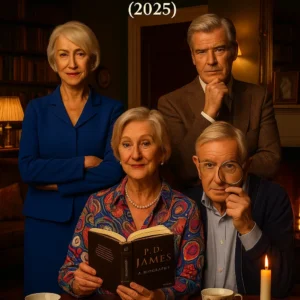On July 9, 2025, Netflix will unveil Brick, a German psychological sci-fi thriller that promises to captivate audiences with its claustrophobic tension and mind-bending narrative. Directed by Philip Koch, known for Tribes of Europa, this film traps its characters—and viewers—behind an impenetrable brick wall that materializes overnight, sparking a desperate struggle for survival and revelation. With a premiere date aligning with the summer thriller season, Brick has already generated buzz for its innovative premise and stellar cast. This article explores the ensemble bringing the story to life, the gripping content that unfolds within a single building, and the unexpected twists that challenge perceptions of reality.
The Stellar Cast
Brick features a dynamic ensemble, led by Matthias Schweighöfer as Tim Arnovsky, a man thrust into a nightmare when his apartment becomes a prison. Schweighöfer, a familiar face from Army of Thieves, brings his signature charisma and versatility, transitioning from action to a more vulnerable, introspective role. His real-life partner, Ruby O. Fee, plays Olivia Neill, Tim’s counterpart whose resourcefulness becomes key to their survival. Fee, seen in Polar and Army of Thieves, complements Schweighöfer with a magnetic presence, their on-screen chemistry adding depth to the couple’s strained relationship.
The supporting cast enhances the tension with standout performances. Frederick Lau portrays Gael, a neighbor whose paranoia escalates under pressure, drawing on his experience from The Wave. Murathan Muslu as Yuri brings a brooding intensity, while Alexander Beyer as Friedman adds a layer of calculated mystery, both actors leveraging their backgrounds in European cinema. Sira-Anna Faal as Lea, Salber Lee Williams as Ana, Axel Werner as Oswalt, and Josef Berousek round out the group, each contributing unique perspectives as the building’s residents grapple with their confinement. This diverse lineup, filmed with a real-life couple at its core, creates a believable microcosm of human behavior under duress.
The Gripping Narrative
Set in a nondescript Hamburg apartment building, Brick opens with an ordinary morning turned extraordinary. Tim and Olivia awaken to find their home encased by a mysterious, futuristic brick wall that seals every exit and window. The initial shock gives way to a grim reality: the entire building and its residents are trapped, cut off from the outside world with no electricity, dwindling water, and no communication. The film’s premise, reminiscent of The Platform and 10 Cloverfield Lane, establishes a single-location thriller where the setting itself becomes a character, its oppressive architecture amplifying the sense of entrapment.
The narrative follows Tim and Olivia as they rally their wary neighbors to uncover the wall’s origin and purpose. Early attempts at escape—brute force, drilling, and desperate searches—yield little, but they stumble upon clues suggesting they are being watched. This discovery shifts the focus from mere survival to a psychological battle, as trust frays and secrets emerge. The story unfolds in a tight 1-hour-39-minute runtime, a deliberate choice to heighten the suffocating rush, with cinematography lingering on anxious faces and shadowy corridors to build dread.
The film’s German roots infuse it with a distinct flavor, blending sci-fi speculation with existential dread. Shot at Prague’s Barrandov Studios, the custom-built set enhances the realism of the enclosed space, a testament to the production’s commitment to immersing viewers. As the residents band together, their interactions reveal personal histories and rivalries, turning the mystery into a study of human resilience and conflict. The lack of immediate answers—Who built the wall? Why?—keeps the tension taut, inviting speculation about social experiments, alien intervention, or a dystopian purge.
The Mind-Blowing Plot Twists
Brick thrives on its ability to subvert expectations, delivering twists that redefine the narrative. The first major revelation occurs when the residents find hidden cameras, confirming they are under surveillance. This shifts the story from a survival tale to a potential experiment, with the wall possibly a controlled barrier designed to test their limits. The discovery, hinted at through subtle visual cues like flickering lights, challenges the group’s unity, as suspicion turns inward.
The second twist deepens the mystery when Tim uncovers a blueprint among Olivia’s belongings, suggesting she may have prior knowledge of the wall. This betrayal, whether intentional or coerced, fractures their relationship and forces a reevaluation of her character. Schweighöfer’s portrayal of Tim’s confusion and Fee’s defensive resolve amplify the emotional stakes, leaving viewers questioning Olivia’s motives and the couple’s past.
The climax delivers the most shocking turn: the wall begins to shift, revealing an exit—but only after a resident sacrifices themselves to activate a hidden mechanism. This revelation implies the wall was a puzzle, its solution requiring a life, and suggests the survivors were pawns in a larger game. The final moments show Tim and Olivia stepping outside to a desolate, unrecognizable landscape, hinting that their world has changed irreversibly. This ambiguous ending—Are they free, or trapped in a new prison?—leaves audiences debating, with the film’s tight pacing ensuring the twist lands with impact.
Critical Reception and Cultural Impact
As Brick premieres on July 9, 2025, early reactions suggest it will be a standout in Netflix’s summer lineup. The trailer, released in June, has sparked comparisons to high-concept thrillers, with its claustrophobic vibe and psychological depth earning praise. The film’s 6.2 IMDb rating reflects initial mixed reviews, but its unique premise and strong performances are expected to drive discussion. Social media sentiment, particularly on platforms where fans dissect trailers, highlights excitement for the Schweighöfer-Fee reunion and anticipation for Koch’s directorial vision.
Culturally, Brick taps into growing interest in dystopian narratives, reflecting anxieties about isolation and control in an increasingly connected world. Its German production aligns with Netflix’s push to expand European content, following successes like Dark and 1899. The film’s exploration of confinement also resonates with post-pandemic reflections on space and community, potentially sparking broader conversations. While some may find the trailer’s reveals limit the surprise, the cast’s chemistry and Koch’s pacing are poised to deliver a memorable experience.
Conclusion
Brick is a bold addition to Netflix’s thriller catalog, weaving a tale of survival, betrayal, and mystery within the confines of a single building. With a cast that brings authenticity and tension, a narrative that builds suspense through its setting, and plot twists that challenge assumptions, the film offers a gripping watch. Premiering on July 9, 2025, it invites viewers to ponder the walls—literal and metaphorical—that define our lives, leaving them with a lingering sense of unease and intrigue.

